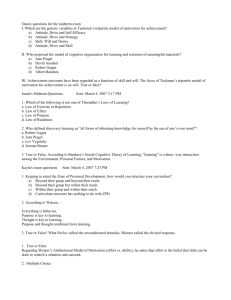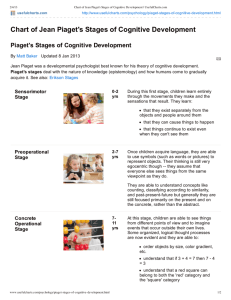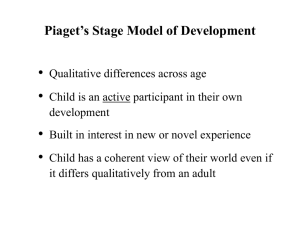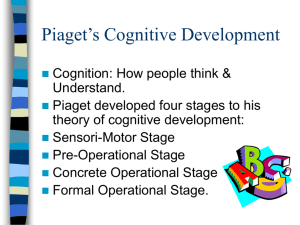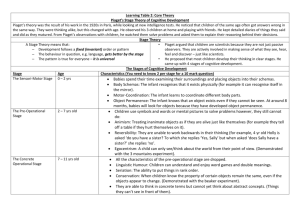Samuel
advertisement
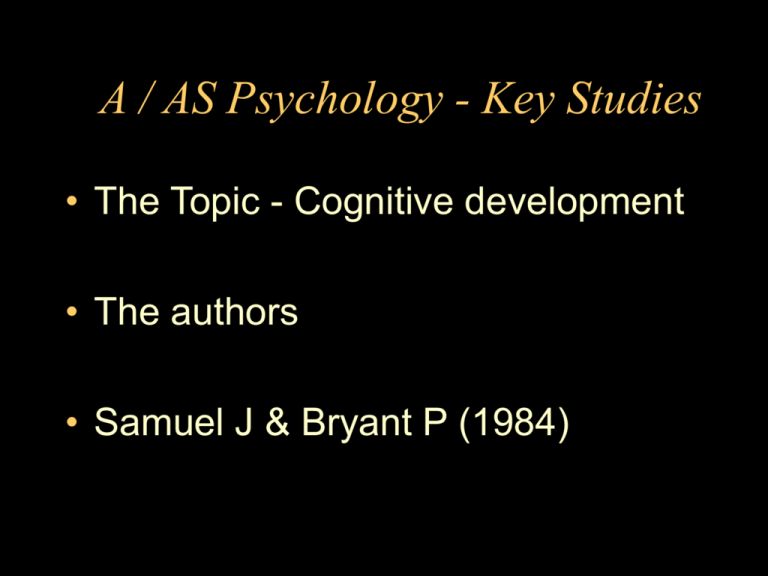
A / AS Psychology - Key Studies • The Topic - Cognitive development • The authors • Samuel J & Bryant P (1984) Samuel J & Bryant P (1984) Can young children CONSERVE or does asking the same question twice cause them to fail? Jean PIAGET and his theory Children’s thought processes are QUALITATIVELY different to adult thought processes Jean PIAGET • Piaget is the most famous writer on children’s cognitive development • Piaget was a SWISS zoologist who studied his own children and their friends Jean PIAGET and his theory • Piaget proposed a maturational theory of cognitive development • NATURE not NURTURE Jean PIAGET and his theory • cognitive development: • the transformation of initial inborn schema by the twin processes of • Assimilation = practise • Accommodation = modification Jean PIAGET and his theory • cognitive development takes place through FOUR fixed age related stages Jean PIAGET and his theory • Stage 1- the sensorimotor stage • birth to 2 years • child learns from interaction with environment • only at about 6 months does OBJECT permanence occur Jean PIAGET and his theory • Stage 2 - pre-operational stage • 2 to 7 years • Child is egocentric - unable to understand the world from another’s perspective • Child unable to CONSERVE Jean PIAGET and his theory • What does CONSERVE mean? • Children can CONSERVE when they understand that quantity does not change when appearance changes Jean PIAGET and his theory • Stage 2 - pre-operational stage • classical conservation test stage 1 RRRRRRR RRRRRRR are there the same number of counters in each row? Jean PIAGET and his theory • Stage 2 - pre-operational stage • classical conservation test stage 2 RRRRRR R R R R R R are there the same number of counters in each row? Jean PIAGET and his theory • Stage 2 - pre-operational stage • conservation test RRRRRR R R R R R R the child who says NO cannot conserve number Jean PIAGET and his theory • Stage 2 - pre-operational stage • another conservation test • 2 rolls of plasticine - is there the same amount in each? Jean PIAGET and his theory • Stage 2 - pre-operational stage • roll one out while child watches Jean PIAGET and his theory • Stage 2 - pre-operational stage • still the same amount in each? the child who says NO is unable to conserve MASS Jean PIAGET and his theory • Stage 2 - pre-operational stage • Another conservation test • 2 containers of liquid - same amount in A as in B? A BBB Jean PIAGET and his theory • Stage 2 - pre-operational stage • Watch while pour B into C • Same amount in A as in C? A B C Jean PIAGET and his theory • Stage 2 - pre-operational stage • same amount in A as in C? • the child who says NO unable to conserve VOLUME A B C Jean PIAGET and his theory • According to Piaget - in all these cases the child can only take into consideration ONE aspect of the physical world at a time (what it looks like) • THUS if it LOOKS different it MUST BE different! Jean PIAGET and his theory • Stage 3 • CONCRETE operational stage • 7 - approx 11 years • child now able to conserve and can perform quite complex operations • but only if ‘real’ objects are ‘at hand’ Jean PIAGET and his theory • the child cannot perform mental operations (transformations) • If Bill is taller than Jim and shorter than John who is the tallest? • Without real figures to manipulate the child cannot answer Jean PIAGET and his theory • If Bill is taller than Jim and shorter than John who is the tallest? • BILL JIM JOHN Jean PIAGET and his theory • • • • Stage 4 Aged 11+ ‘Formal Operations’ this is where the 11+ came from! The child can now perform logical operations and abstract reasoning • According to Piaget not all achieve the stage of FORMAL OPERATIONS Jean PIAGET and his theory • Samuel & Bryant criticised PIAGET • they believed that children could conserve at an earlier age than Piaget maintained. • they thought the children answered the way they did because of the way the experiment was carried out Jean PIAGET and his theory • IN SUM • Samuel & Bryant criticised PIAGET • they thought that the experimental method and the repeated questions generated • DEMAND CHARACTERISTICS standard conservation test • Question 1 Are there the same number of counters in row A & B? A RRRRRR B RRRRRR child answers YES standard conservation test stage 2 • Child watches the transformation A RRRRRR B R R R R RR standard conservation test stage 3 • Question 2 Are there the same number of counters in row A & B? A RRRRRR B R R R R RR child answers NO failing to conserve Samuel & Bryant (1984) Set up an experiment to try to demonstrate that asking the same question twice caused children to make errors in the standard conservation test Samuel & Bryant (1984) • • • • The participants - 252 boys & girls aged 5 to 8.5 years four groups of 63 mean ages 5 yrs 3 mths 6 yrs 3 mths 7 yrs 3 mths 8 yrs 3 mths Samuel & Bryant (1984) • Here we have a naturalistic IV - age • then groups divided into 3 sub groups (21 in each sub group) • (1) Standard Group • Traditional conservation task • asked two questions Samuel & Bryant (1984) • (2) One Judgement Group • Only one question asked • AFTER the transformation • (3) Fixed Array • Saw only ONE display - the post transformation one Samuel & Bryant (1984) • Procedure each child given 12 separate trials 2 equal 2 unequal mass (plasticine 2 equal 2 unequal number (counters 2 equal 2 unequal volume (liquid Samuel & Bryant (1984) In this experiment What are the IVs What is the DV How did S & B measure the ability to conserve (operationalise the DV) Why did S & B include an unequal condition in the pre transformation Samuel & Bryant (1984) mean errors for each group age 5 6 7 8 standard 1 question 8 7 6 4 3 3 2 1 fixed array 9 6 5 3 Samuel & Bryant (1984) mean errors for each group standard Mass 2 Number 1 Volume 2 1 question 1 1 2 fixed array 2 2 3 Samuel & Bryant (1984) age 5 6 7 8 standard 8 6 3 2 1 question 7 4 3 1 fixed array 9 6 5 3 • How did performance differ by age ? • How did performance differ between experimental groups ? • Do these results support Piaget? Samuel & Bryant (1984) Methodology ? naturalistic experiment (IV = age) cross sectional experimental (IV = condition) repeated measures and independent groups Ecological validity ? Participant bias - was there any? Ethical concerns - are there any ? Samuel & Bryant (1984) Children’s ability to conserve Situation vs dispositional attribution What do you think?
